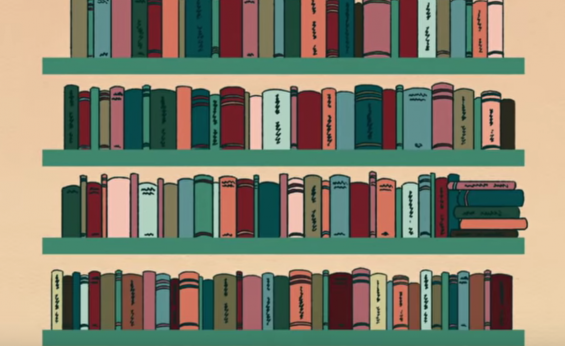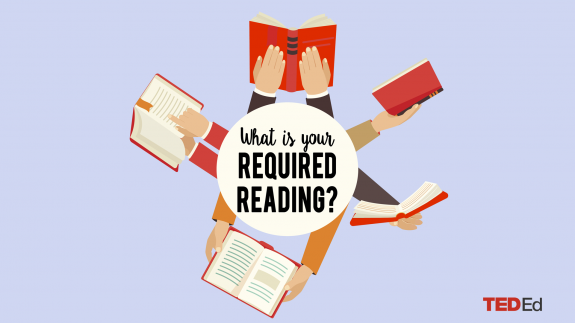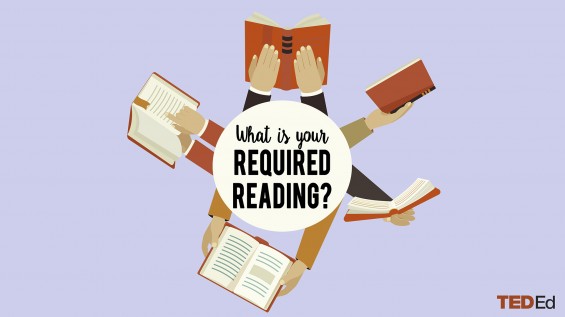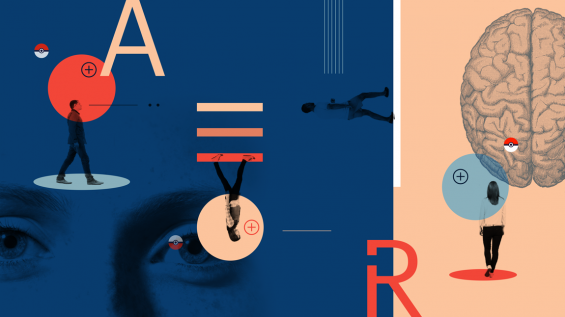
The world’s required reading list: The books that students read in 28 countries

This compilation of reading assigned to students everywhere will expand your horizons — and your bookshelves.
In the US, most students are required to read To Kill a Mockingbird during their school years. This classic novel combines a moving coming-of-age story with big issues like racism and criminal injustice. Reading Mockingbird is such an integral part of the American educational experience that we wondered: What classic books are assigned to students elsewhere?
We posed this question to our TED-Ed Innovative Educators and members of the TED-Ed Community. People all over the globe responded, and we curated our list to focus on local authors. Many respondents made it clear in their countries, as in the US, few books are absolutely mandatory. Below, take a look at what students in countries from Ireland to Iran, Ghana to Germany, are asked to read and why. [Note: To find free, downloadable versions of many of the books listed below, search Project Gutenberg.]
Afghanistan
Quran
What it’s about: The revelations of God as told to the prophet Muhammad, this is the central religious text of Islam and remains one of the major works of Arabic literature.
Why it’s taught: “Overall, there is no culture of reading novels in my country, which is sad,” says Farokh Attah. “The only book that must be read in school is the holy Quran, and everyone is encouraged to read it starting from childhood.”
Albania
Kronikë në gur (1971) by Ismail Kadare
What it’s about: Known in English as Chronicle in Stone, this novel is told through the eyes of a child and shows how different conquering forces — Italian fascist, Greek and Nazi — ravage a small Albanian city during World War II.
Why it’s taught: Kadare is one of the most critically acclaimed Albanian writers, and was nominated several times for the Nobel Prize in Literature. This book “helps you understand vividly what World War II meant for the people who lived through those events,” says Vaitson Çumaku. “Because it’s from the perspective of a child, it also shows you that there can be optimism during hard times.”
Australia
Tomorrow, When the War Began (1993) by John Marsden
What it’s about: A teenage girl and her friends return from a camping trip to find that an unidentified foreign military force has invaded Australia.
Why it’s taught: This book “speaks to our fear of invasion and our fighting spirit,” says Beth James Waters. It also “beautifully portrays the vastness of and abundant natural dangers in our land.”
Austria
Faust (1787) by Johann Wolfgang von Goethe
What it’s about: In this play, a scholar named Faust makes a pact with Mephistopheles — the devil — because Faust is dissatisfied with life. The devil says he will grant Faust a transcendent moment, but in return, Faust must act as his servant for eternity in hell. Through the devil’s intervention, Faust falls in love with a beautiful young girl named Gretchen. Tragedy ensues.
Why it’s taught: It raises many vast philosophical debates, including science versus spirituality, reason versus passion, and salvation versus damnation, and “it can be interpreted in many ways,” says Barbara Paulmayer. “Faust is not as easy to understand as newer pieces of literature, so it stimulates students to think in a different way.” In addition, its plot and themes have gone on to influence many other works.
Bosnia; Serbia
Na drini ćuprija (1945) by Ivo Andrić
What it’s about: Known in English as The Bridge on the Drina, this novel sweeps through 300 years in a small town near the Mehmed Pasha Sokolović bridge. Its story begins in the 16th-century Ottoman Empire, when the bridge was built, to World War I, when it was partially destroyed.
Why it’s taught: Andrić received a Nobel Prize, and so far he has been the only Nobel Prize winner from Serbia, Croatia and Bosnia. “It is truly a timeless book,” says Martin Kondža. “Its themes and stories also apply to humanity today. The bridge acts as a dumb witness to empires being born and crushed, human lives reaching their peaks and depths, and countries being established and destroyed.”
Brazil
Morte e vida Severina (1955) by João Cabral de Melo Neto
What it’s about: Known in English as The Death of a Severino, this play in verse is about the arduous journey of a man who is fleeing the drought- and poverty-stricken northeastern region of Brazil in search of a better situation and the city.
Why it’s taught: “It shows the dual conditions that the country has always presented and still presents — poor lives, inequality, ignorance, and silent people, versus a city population, with all its advantages — and the distance between these two groups,” says Andrea Rodrigues.
Bulgaria
Under the Yoke (1894) by Ivan Vazov
What it’s about: This novel looks at a Bulgarian village under Ottoman rule and depicts a failed insurrection in the 1870s that helped trigger the country’s eventual breakaway. The large cast of characters includes villagers on both sides of the rebellion.
Why it’s taught: For one thing, Vazov is seen as the father of Bulgarian literature. But, adds Kristine O’Malley, “Being enslaved by the Ottoman Empire and the struggle for independence have shaped the national identity of Bulgarians,” making this book a perennially popular read.
Canada
The Wars (1977) by Timothy Findley
What it’s about: Robert Ross, a 19-year-old Canadian, tries to cope with the death of his sister by enlisting to fight in World War I. Beset by his own demons, he travels to France where he fights in the trenches and sees the worst of warfare — and of humanity.
Why it’s taught: “It’s an iconic Canadian novel. It’s so brutally honest in its depiction of war, sorrow, and coming to terms with an uncaring world in one’s own way,” says Karen Goepen-Wee. “This text does not tread lightly around the angst and horror of World War 1 for Canadian soldiers,” says Will Gourley.
Chile
Sub Terra (1904) by Baldomero Lillo
What it’s about: This short-story collection is about the backbreaking, impoverished, dangerous existence of coal miners in southern Chile in the late 19th century.
Why it’s taught: “Sub Terra represents an important part of Chile’s history,” says Natalia Salamanca Moreno. “These stories show students a lifestyle that is completely different from theirs today, which can help them appreciate what they have now. The stories also emphasize important, timeless family values, like being thankful for your parents and their efforts.”
China
Analects by Confucius
What it’s about: This book is a compilation of the teachings of the ancient philosopher Confucius; it’s believed to have been written sometime between 475 BC and 221 BC.
Why it’s taught: “Teachers want students to learn good morals from the Analects, like showing respect to your parents, learning merit from others no matter their status, and using critical thinking,” says Aylee Lu. “This book remains a cornerstone of Chinese culture.”
Colombia
Cien años de Soledad (1967) by Gabriel García Márquez
What it’s about: This pioneering fictional work of magical realism — known to English-language readers as 100 Years of Solitude — traces the rise and fall of a fictional Colombian town through five generations of the Buendía family, starting in the early 19th century.
Why it’s taught: Márquez is considered one of the most important writers in the Spanish language, and he was awarded the Nobel Prize in Literature in 1982. This novel depicts the violence that has plagued Colombia for decades, and “shows how much corruption and suffering Colombians have endured,” says Daniela Ramirez Barreto. “Yet there is something about us that refuses to give up.”
Cyprus
The Murderess (1903) by Alexandros Papadiamantis
What it’s about: This novella is about an old woman named Hadoula who lives on the island of Skiathos. She murders poor young girls as a kind of mercy killing, since she views their future prospects to be limited and bleak.
Why it’s taught: “It sheds light on the role of women and on gender roles within marriage; these are of great importance in Cyprus and Greece,” says Evanthia Poyiatzi. “And it makes students decide whether the woman’s behavior is ethical or unethical.”
Egypt
The Days (1935) by Taha Hussein
What it’s about: This book is the autobiography of intellectual and writer Hussein, who lived from 1889 to 1973. He became blind at the age of 3 but grew up to be the minister of education in his country and is one of the most influential figures in Egyptian literature.
Why it’s taught: The book teaches students “the importance of gathering knowledge, the need to rebel against traditions and the negative effects of ignorance upon individuals in a society,” says Mahmoud Attalla.
Finland
Seitsemän veljestä (1870) by Aleksis Kivi
What it’s about: Known in English as Seven Brothers, this book is about a quarrelsome family of seven brothers and their struggles in rural Finland. They eventually grow and mature into decent members of society.
Why it’s taught: It is believed to be the first truly Finnish novel by a Finnish author in the Finnish language about ordinary people. “It’s considered the national novel of Finland,” says Jaani Länsiö. “It’s about Finnish stubbornness.”
Germany
Tagebuch der Anne Frank (1947)
What it’s about: Known in English as The Diary of Anne Frank, this journal was kept by a Jewish girl named Anne Frank as she lived with her family in hiding in Amsterdam under Nazi occupation.
Why it’s taught: “We should never forget what horrors were unleashed by narrow-thinking people,” says Charlotte Böhm.
Ghana; Nigeria
Things Fall Apart (1958) by Chinua Achebe
What it’s about: Set in Nigeria in the 1900s, this novel follows Okonkwo, an Igbo leader and village wrestling champion, his journey to power and glory, and his eventual fall when he fights back against white colonialists.
Why it’s taught: “On the surface, it’s a celebration of African traditionalism and how those ideals were washed away with the coming of the missionaries,” says Ama Y Adi-Dako. “At the heart of it, though, it is a critical look at the concept and drawbacks of African and tribal masculinity.”
India
Autobiography: The Story of My Experiments With Truth (1927-1929) by Mohandas K. Gandhi
What it’s about: The Indian leader’s memoir covers his life from his childhood to his early 50s.
Why it’s taught: “This book upholds the essence of living a life with dignity, which is possible only through truth and nonviolence,” says Bismi Sain.
Indonesia
Laskar Pelangi (2005) by Andrea Hirata
What it’s about: Known in English as Rainbow Troops, this novel is based on a true story about ten students from a remote village in Indonesia who, with the help of a pair of inspiring teachers, learn to stand up for themselves and their community.
Why it’s taught: It teaches “sacrifice, dedication, hard work, passion, brotherhood, friendship, optimism and perseverance in the face of challenges,” says Mahrukh Bashir.
Iran
Poems by writers such as Hafiz, Sa’Addi, Ferdowsi, Rumi and Khayyam
What they’re about: Love, beauty, joy and other themes.
Why they’re taught: “In Iran, the novel is a relatively newer form of literature,” says Ne Da. “But among our literary classics are abundant poets and poetry. Each poem speaks to a different value.”
Ireland
Ice Man: the Adventures of an Irish Antarctic Hero (2003) by Michael Smith
What it’s about: It’s a biography of Tom Crean, an Irish boy who ran away from home at the age of 15 to join Captain Robert Falcon Scott’s Antarctic voyage. He was also a member of Ernest Shackleton’s Endurance expedition.
Why it’s taught: “It shows that the Irish are ambitious explorers who can triumph over adversity and that through hard work, focus and dedication, everything is possible,” says Naoimh Riordan.
Italy
I Promessi Sposi (1827) by Alessandro Manzoni
What it’s about: Known in English as The Betrothed, this novel takes place in northern Italy in the first half of the 17th century. Italy was not yet a nation, and this book shows the lives of villagers living under repressive Spanish rule as well as the impact of a deadly plague that killed many people.
Why it’s taught: “I Promessi Sposi is one of the two pillars of Italian literature,” says Sofia Ramundo. “It is considered the blueprint for historical novels,” says Michela Sacchi O’Brien.
Pakistan
The Reluctant Fundamentalist (2007) by Mohsin Hamid
What it’s about: An international bestseller, this novel follows the story of a Pakistani man as he reflects on his time in the United States before and after the events of September 11, 2001.
Why it’s taught: “These books touch the unique dilemmas faced by modern Pakistanis who are struggling with fundamental ideals and trying to find their own identity,” says Vajiha Atiq.
Philippines
Noli Me Tangere (1887) by Jose Rizal
What it’s about: Rizal went on to be a hero of the Philippine revolution, and his novel — the English-language title is Touch Me Not — shows life in the Philippines society under cruel, repressive, arbitrary Spanish Catholic rule.
Why it’s taught: By combining a dramatic story with an activist message, this novel has been compared to Uncle Tom’s Cabin by Harriet Beecher Stowe. It is taught to help students “appreciate the efforts of our forefathers in shaping our independence,” says John Eric Uy.
Russia
War and Peace (1869) by Leo Tolstoy
What it’s about: Following the lives and loves of five families, this epic novel begins in 1805 and continues through Napoleon’s 1812 invasion of Russia.
Why it’s taught: War and Peace “is basically speaking about every aspect of our life: how to be valuable in society, how to be forgiving, and how to be respectful,” says Valentina Ishmanova. “I believe everyone goes through the same situations as Tolstoy’s characters Natasha, Pierre, and Prince Andrei.”
US
To Kill A Mockingbird (1960) by Harper Lee
What it’s about: A classic novel about the American South in the 1930s that illustrates how racism, sexism and injustice have shaped US history (and still cause harm today).
Why it’s taught: “We’re still dealing with racism and systematic prejudice, especially in the legal system in the US,” says Shaun McGovern. [Extra Resources: Teaching Mockingbird.]
Vietnam
Truyện Kiều (1820) by Nguyễn Du
What it’s about: It’s an epic narrative poem about a young woman named Thuý Kiều who is driven to sacrifice herself to save her family.
Why it’s taught: Known in English as The Tale of Kiều, the poem shows “the humanity and the beauty of my country,” says Joy Truong, who adds that she likes its positive qualities, a stark contrast to most other stories and poems which “focus on the difficulties of the Vietnamese.”
Laura McClure is the TED-Ed Editor. Daryl Chen is the Ideas Editor at TED. The article above is adapted for TED-Ed Blog from this Ideas.ted.com article. To learn something new every week, sign up for the TED-Ed Newsletter here >>




Quran for All languages
http://www.listenquran.online
I don’t know what part of Indian union has this title by Mohandas Gandhi as a required reading. In Tamil Nadu, I did not have this as a requirement but instead I cherish reading Tirukkural every year in middle and high schools.
Excellent to know the global culture and issues
VENEZUELA: Doña Bárbara (1929) by Romulo Gallegos.
What about Mexico? We might not be good readers but there are some great books. Pedro Páramo or Llano en Llamas by Juan Rulfo for instance. José Emilio Pacheco is also a great writer. El viento distante, Pedro Páramo and Llano en Llamas are forced readings for mexicans. (BTW I am not angry, just showing other info that could work for this post)
I know, I was looking for Pedro Paramo too; after all, Cien años de soledad was inspired mostly in Mexican literature.
Juan Rulfo’s Pedro Páramo and El Llano en Llamas definitely top of the list; I also fondly remember La Sombra del Caudillo (Martín Luis Guzmán), Rito de Iniciación (Rosario Castellanos), and Recuerdos del Porvenir (Elena Garro). Two often found in required reading lists are Al Filo del Agua (Agustín Yáñez) and La Región Más Transparente (Carlos Fuentes), but I’m yet to read those two.
Thank you for these titles!
Also “El laberinto de la soledad” by Octavio Paz. Some others are Rayuela by Julio Cortázar; “Ensayo sobre la ceguera” By José Saramago; and “Cien años de soledad” By Gabriel García Márquez; and Even though none of them are mexican but (Argentinian, Portuguese , Colombian )
I want to reaffirm that I love Truyện Kiều because it’s humanity to women in particular and people in general, not because that contrasts with most others. Vietnam used to be in difficult and challenging situations but somehow I still love my country and the way people survived and overcame the obstacles which I learned through books and poetry.
It’s very difficult to acquire the beauty of Truyện Kiều as the excellence mainly lies in the beautiful language and the author is a master in using it. The story originated from a Chinese plot but was adapted by Nguyễn Du in a very human way I think. So Truyện Kiều cannot describe Vietnam but the women’s conditions at that time.
Sorry I made some misunderstanding about my comment.
Thank you for the list, I really love it and TED-ed, I tried “To Kill a Mockingbird” and was really touched, it’s very excellent.
In India it is Bhagavad Gita…or simply Gita…which is read by students along with complete work of Swami Vivekananda….
Gita teaches- God is – in and out of everything…hence this universe its people everything belongs to God…..by and large it teaches God is the self of all living beings ….which makes them breath….& makes the body work…likewise the same self runs the universe…sun …moon everything ….it’s seamless ….absolute consciousness …..absolute intelligence…
Interesting England is not mentioned? Could not choose an author? Shakespeare or Dickens???!!!!
I think the authors figured the canon of literature in the US is already strongly reflecting the English canon.
Thank you, interesting to know what’s being read around the world. My daughter and I have only read one of these books. That’s about to change.
I would like to add the one from my country: Spain- Don Quixote 1605 (by Cervantes contemporary pf Shakespeare) which is considered one of the earliest canonical novels in the Western culture with multiple references and influences to later works. It tells the story of a man who looses his mind after reading many chivalric novels and decides to travel Spain and fight injustice as a knight.
Though difficult to understand without guidance, I believe it shows the reader how imagination and reality are interwined in the world that we live each day. It also presents how, as the characters in the novel Don Quixote and Sancho, one should not be over optimistic or pesimistic but, as Aristotle said, it is desirable to stay in the middle.
Cool & enlightening
Actually im not sure if its true that german students all read Anne Franks Diary. Everyone I know needed to read Goethe (Including Faust) and Franz Kafka
True we didn’t read Anne Frank, but Goethe and Kafka was a must
I’ve read Anne Frank in school, and pretty much everyone i know (growing up in Germany) has read it.
It is a list of 26 countries only.
“TED-Ed Blog – The world’s required reading list: The books that students read in 28 countries”
It’s 28 — Ghana and Nigeria are together, as are Bosnia and Serbia!
Croatia – Miroslav Krleza – Gospoda Glembajevi or Messrs. Glembay
POLAND
“Pan Tadeusz, czyli ostatni zajazd na Litwie. Historia szlachecka z roku 1811 i 1812 we dwunastu księgach wierszem” (English title: “Sir Thaddeus, or the Last Lithuanian Foray: A Nobleman’s Tale from the Years 1811 and 1812 in Twelve Books of Verse”) by Adam Mickiewicz (First published in 1834)
What it’s about:
It recounts the story of two feuding noble families and the love between a young man of one family (the title character) and a young girl of the other with the historical events in Poland (non-existent on the political map of Europe at that time) in the background.
Why it’s thaught:
In Poland Adam Mickewicz (1798-1855) is one if of the tree National Great Bards (along with Juliusz Słowacki and Zygmunt Krasiński) and “Pan Tadeusz” is recognised as a Polish national epic poem (and compulsory reading), because it tells a trivial love and war story during turmoils in the re-birting Poland.
[btw, Mickiewicz is often regarded by Lithuanians to be of Lithuanian origin and Belarusians proclaim him to be one if them as he was born on the territory of contemporary Belarus]
Armenia is one of the oldest countries in the world, yet it is not mentioned. Therefore, I humbly recommend my novel Armenia’s Fingerprint now offered at Amazon books. It tells the story of teen sisters who fight valiantly against the Turkish army during the Armenian genocide of World War I. The novel is historical fiction based on true stories told to me by my grandmother who was a survivor of the genocide.
Iran
It is completely right about Iranian students who study famous poems from classical writers, such as Hafiz, Sa’Addi, Ferdowsi, Rumi and Khayyam.
It is such a wonderful list. I must day that growing up in both Serbia and Bosnia we are proud of a novel like The bridge on the Drina, but War and Peace is also a mandatory book in high schools here. However, my personal favorite is To kill a Mockingbird which I read in college and ever since I haven’t been able to find a novel worthy to be its oponent.
In the UK, until a couple of years ago when it was removed, To Kill a Mockingbird, was a key text in secondary schools. Now Jane Eyre, Great Expectations and A Christmas Carol, and Macbeth are required reading.
Charlotte Bronte, Charles Dickens, and Jane Austen are some of my favorite authors. You just can’t find the same kind of depth in modern authors, and much of the topics the classic authors touched upon are still relevant today. Also reading the classics is an excellent way to strengthen ones vocabulary and comprehension. I was homeschooled and was required to read several classics, but I really read them by choice, and still enjoy reading them today.
In addition to the Philippines, El Filibusterismo which is a required reading for Grade 10. It is the continuation of Noli me Tangere.
Laskar Pelangi, Indonesia. I am so happy to see this novel on the list! That was the first ever novel I read as I turned 14 years old. It’s not just a novel, it’s a real story!
Here in the Philippines, we were required to read two books actually: Noli Me Tangere and its sequel, El Filibusterismo. Usually read and taught during our third and fourth years of highschool.
I don’t recall any required reading in my high school years in the 1950′s. I selected my own reading. My most memorable book at the time was Doctor Shivago by Boris Pasternak. Some of the books I read would probably not have been recommended by me teachers.
don’t put spoilers in the summaries damn
Why you didn’t mention Croatia?!
Also, Ivo Andrić is Croatian writer born in Bosnia and is also popular as a writer in Croatia, but it is wrong that he is the only Nobel Prize winner from those areas. There are also two other Nobel Prize winners in chemistry: Lavoslav Ružićka and Vladimir Prelog. It’s true that Ivo Andrić is the only winner of Nobel Prize in literature, but then you have to write like that…
Can you please change that fact, as other readers will learn wrong information.
Thank you!
Indian context is wrong… have read in the CBSE and have known ICSE board too but in non of the state boards too this book- my experiment with truth is taught. Absolutely baised as these authors have no context to reality. We are taught or we read Ramayana and Mahabharata as they have the essence of life and experiences of learned – it shows the ups and downs, the sentiments which lead to unseen situations and why at times we continue to work or fight – karma
Spain: “El Ingenioso Hidalgo Don Quixote de la Mancha” (1605 and 1615) by Miguel de Cervantes (in English, ‘Don Quixote’)
Very insightful and interesting list but puzzling to only see one book for USA and no mention of the BIBLE¿
I’m from Australia. Back in the days when I was young and taught literature in a secondary school, the first book which was read and discussed was To Kill a Mockingbird. But recently, as I heard from my former colleagues, it was replaced by local writers works. What I was very sad to hear about. Recently, I’ve found a great guide on the book which will help not only discover its plot summary but allows to dig a little bit deeper into the characters and value of the work for world culture in general:
https://studentshare.net/student-help/to-kill-a-mockingbird-guide/characters-description-and-analysis
I still consider that To Kill a Mockingbird is a must-read book. And not only in Australia but for students all around the world.
In the UK, do most students read Vera Brittain’s Testament of Youth on WWI?
actually, I believe brazilian students had not read this book, nevetheless it is a very good one. I would add “Dom Casmurro” on the list of books I think everyone should consider reading, though…Thanks for adding Brazil, by the way,it is good to be recognized somewhere.
Required reading:
Azul ( Blue) by Ruben Darío
Short stories, poems.
Cantos de Vida y Esperanza by Ruben Darío.
Hyms to life and Hope
Poems, modernist tradition is established in the Spanish language.
In the Philippines, reading “Noli Me Tangere” must be followed “El Filibusterismo,” its sequel. Reading “Noli” and “Fili” is required under a law passed by Congress.
This was a great list, I will try to read all the ones I did not know about. Thank you.
For my country – Trinidad and Tobago – a local book that I read in secondary school that still resonates with me today is ‘A Brighter Sun’ by Samuel Selvon.
It is a book about TnT during the time of World War II and all the issues the citizens dealt with – racism, sexism, culture and religion. It begins with 17 year old Tiger being awoken and told to get dressed good because he was getting married today!
I think everyone could enjoy it even if you are not from here.
Thanks again.
Thank you for this fantastic list, and also for all the comments and the recommendations in them. I could a book for Hungary. A required reading is Ferenc Molnár: The Paul street boys.
gracias por la lista en serio gracias
“El Señor Presidente” for Guatemala. It was written by Miguel Angel Asturias, Nobel Prize for Literature winner.
Although the list is good information but not all inclusive, the comments are valuable as well. Perhaps this could be the beginning of a New project?
Good work. Thanks
So, one of the richest and most spoken languages (Spanish) doesn’t even get a section?
Either Spain is completely forgotten internationally and culturally or these guys who wrote the article didn’t do their homework properly. Terrific. (I normally don’t defend my country in most aspects but this is preposterous)
I’m wondering what is required reading in school in France. Is it Les Miserables or Hunchback of Notre Dame by Victor Hugo or Three Musketeers by Alexander Dumas or Madame Bovary by Gustave Flaubert? Of course, it can also be France’s epic poem “Song of Roland”. Can somebody who grew up in France–please chime in. Merci beucoup, Antoine
I was expecting GREECE on this list cause we acquire to read the OLDEST book of ALL of these on your list!
ODYSSEY by Homer
All greek students know that.
Students in Australia don’t have to read ‘Tomorrow When the World Began’. A few years ago it was quite popular as a textual study, but not required.
Love that people are posting the required reading for additional countries…and corrections too!! Please keep doing so. I keep returning to add to my list.
Would someone please add in comments what book(s) are required reading in Israel?
Thank you!